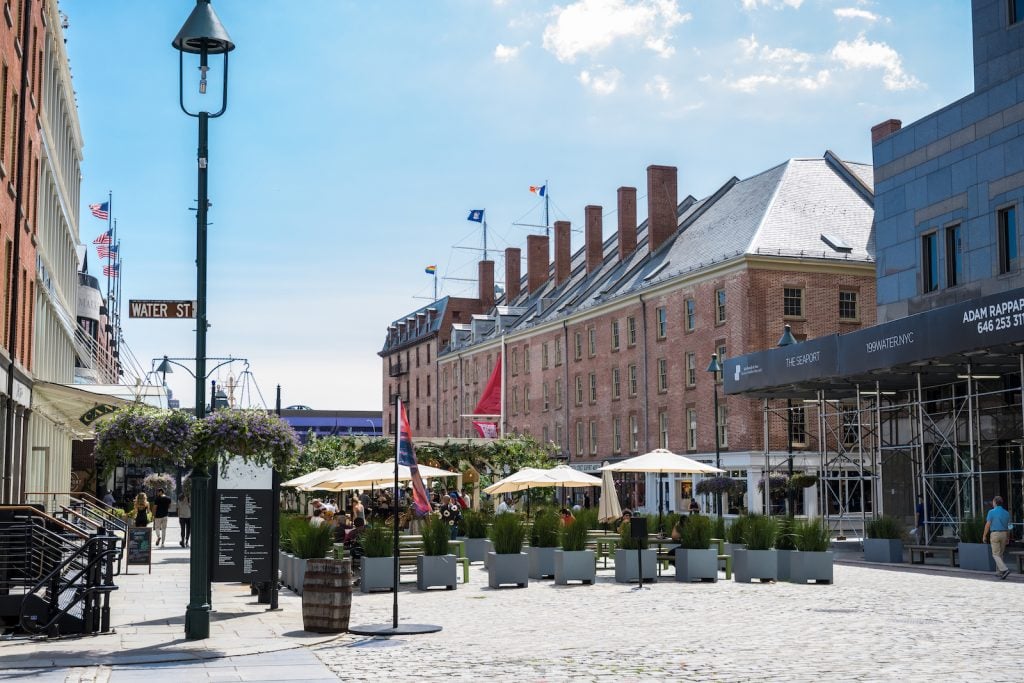Six months into the U.S. pandemic lockdowns, the fate of an institution devoted to the history of one of the country’s oldest cities hung in the balance. The South Street Seaport Museum, which has preserved the artifacts of New York as a port city since 1967, raised an alarm in an email from its president and CEO, Jonathan Boulware.
“Ours is a sacred charge, but we must act quickly,” he wrote. “At present stripped-down levels of funding, the museum will not survive 2021.” The Seaport Museum was hardly alone; two months later, the Alliance of American Museums reported that nearly a third of museums said they were at risk of closure.
Now, the storm has passed, and there is smooth sailing ahead, Boulware has announced. The museum just secured a $40 million gift from a real-estate developer in exchange for its air rights, a move approved by the New York City Council last Wednesday. The city has also pledged to give the institution $10 million.
“To say I’m thrilled would be an understatement,” Boulware told Artnet News.
But others are less on board with the plan—or, more specifically, with the plans for the air rights. The museum sold its rights to build in the South Street Seaport historic district to the Howard Hughes Corporation, which will use them to erect a 324-foot residential tower at the site of a nearby parking lot at 250 Water Street. (The museum’s rights can be used at another location in the area). The company bought the lot for about $180 million in 2018.
The corporation, whose chairman is billionaire hedge-fund manager Bill Ackman, pledged the gift on the condition its plan be approved. A lawsuit aiming to block the project, filed by a coalition of neighborhood groups under the name the Seaport Coalition, was dismissed in October, but only for being filed too early in the land use process. The judge noted that the group could sue again.

The South Street Seaport Museum. Courtesy the museum.
“Those air rights could have been sold to a different developer, for a site other than 250 Water Street or outside the district,” said David Sheldon, representing a group called Save Our Seaport (whose slogan is “for sail, not for sale”), which signed on to the lawsuit. Preservationists say the tower would block views of the Brooklyn Bridge and disrupt the character of an 11-block historic district in Lower Manhattan that was placed on the National Trust For Historic Preservation’s list of America’s most endangered places in 2015 due to “looming development.”
Developers have lusted after the 250 Water Street site for decades, but no previous plan has gotten this far. Local councilwoman Margaret Chin and borough president Gale Brewer supported the Hughes Corporation’s plan based on its promised gift to the museum and the inclusion of 70 units for low-income tenants, though both had opposed earlier tower plans. Brewer rejected a 2014 Hughes plan, saying that “building a tower at the South Street Seaport is like building a tower at Colonial Williamsburg.”
“We’re obviously encouraged to see the museum succeed,” said Sheldon. “We just didn’t believe that it should be at the expense of the historic district.”
Boulware, who has been at the museum for 10 years, as director since 2013, contends that in all his time, no workable plan has emerged. He points out on the museum’s website that New York Times architecture critic Michael Kimmelman also approves of the plan.
“The many other versions of this that have been tried have all failed,” he said. “I accept the idea that in concept there could be a different solution but there hasn’t ever been one and we’ve had decades to see that. This is a solution and it’s one that actually works.”
“Everyone is entitled to their own priorities based on values and perception,” he said. “The district is completely unique in that it is the birthplace of a metropolis with a museum as its beating heart. So if the museum were to be lost, which is what the other fork in the road looked like, what is left? A bunch of old buildings.”
The museum’s survival means it can display its collection of some 28,000 works of art and artifacts as well as more than 55,000 historic records and a fleet of ships that tell the story of New York’s rise as a port city and its crucial role in the rise of the U.S. economy, he said.
“We have a collection that is the crown jewels of maritime New York, and very little has been available to the public. This $40 million, and $10 million in capital funding from the city, is the stabilizing force which means we can provide these beautiful elements to the people of New York. We have this incredible dowry that we must share. The greatest city in the world deserves a maritime museum worthy of its place in the world, and that is what we intend to create.”







